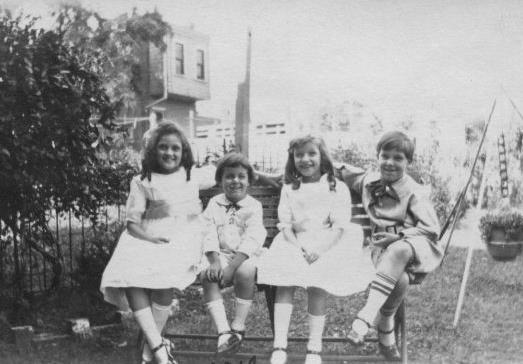
Figure 1.--This family snapshot was taken in 1918. It was in a batch of French photographs although it looks rather American to us. The older boy wears what looks like a dressy home smock (or perhaps a tunic). The girls wear dressy white frocks. |

|
HBC still has relatively limited information on smocks for homewear in the 20th century. We suspect that smocks worn at home was fairly common in the early-20th century. We see both snapshots and commrcial postcards. Snapshots are of coure a much better indivator of actual prevaleve than commercial postcards. This seems to have been common in the the early-20th century at least among affluent famlies. We are not sure about gender conventios. We see no evidence that home smocks were was common among working-class families. But we do not have many working-class family images to substantiate this. This is not to say that working-class boys did not wear smocks. They were standard wear at French schools both before and after the turn-of-the 20th century. A private schools were not as common in France as in America and Britain. Boys from affluent families were mich more likely toatend public schools. Both boys and girls wore them. We no longer see French boys wearing smocks st home after World War I. Our French archive is limited, but we believe we have enough images to make a preliminary assessment. We see smocks continue to be commonly worn at French schools througout the 1930s and into the 1940s. Teyseen especially common in rural ares. For some reason they begin to decline after World War II (1939-45). They have not totlly dsapprared, but are now not very common.
HBC has noted a few images from the 1900s suggest that some French mothers had their boys wear smocks as play garment. we know that boys commonly wore smocks to school. We are unsure why we have found so few homeimages of boys wearing smocks at home. We have much less information on homewear. We do not know, however, how long this was a common fashion. We note Emil Zola's son, for example, playing in gingham smocks. Perhaps smocks as homewear was an upper-class fashion. Our limited information at this time, however, makes it impossible to accurately report on trends.
HBC believes that French boy s began to wear smocks less commonly at home during the inter-war era. During this period smocks became to be seen primarily a school garment. One factor invplved here is that rompers became such a popular garment for pre-school boys. Such boys who earlier might have been dressed in smocks, were in the inter-war dressed in rompers. Smocks did not disappear, but just became less common. Some boys wore smocks over their rompers. A French reader reports that after 1925, it became increasingly popular to create what can be called 'happy clothes' for both boys and girls.
By the mid-1930s these 'happy clothes'at was even more common. This trend certinly affect French smocks, but we have few details at this time. We do not many children wearing black school smocks in the photographic record. Many of the images show the children out of school. Usually it is not clear if they are wearing the smocks as aormal garment or if they are just on the way home after school. We suspect that many children just never bothered to change after school as we often see images with some children wearing snock and other their regular clothing. We continue to archive French images and hope to learn more as our archive expands. One thing that seems clear, the black school smock was the primary smoxk worn by French children. There were other colors as well as patterns, but they so not show up significntly in the photographic record.Ther is no way of being precise, but something like 95 percent of the smocks we see are the black school smocks. This is especilly the case of the boys wearing smocks.
As far as HBC know, the only smocks commonly worn by French boys were school smocks. Available images from the 1940s and 50s suggest that smocks were still very common in French primary schools. There were quite a range of different styles that were worn. Some boys' styles were very destinctive. Other styles could we worn by either boys or girls, although only very young boys wore smocks that tied in a bow at the back. HBC has collected images of schools smocks that were commonly worn by French children in the 1950s, showing the great variety.
By the 1960s, smocks declined in popularity. Most boys would take their smocks off as soon as they came home from school. We have not noted many images of French boys playing in smocks after the 1950s.
Schools smocks virtually disappeared in France during the late 20th century. The only exception appears to be very young children at nursery schools. Perhaps some primary children may have worn them, but HBC has no indication that they did. Hopefully French readers will provide us some information here. One reader reports, "I am not sure that smocks were limited to nursery schools, there might well have been few private schools (catholics) requiring smocks during whole of primary level." A HBC reader reports, "The wearing of dad's old shirt is nowadays quite common in France and Switzerland during "dirty" lessons of manual work such as painting in nursery and first primary levels. I believe in is
also the case in other European countries that have never had school smocks."
Navigate the Boys' Historical Clothing Smock-related pages:
[Return to the Main national smock page]
[Pinafores]
[Fauntleroy suits]
[Fauntleroy dresses]
[Sailor hats]
[Park outings]
[French page]
[Renoir page]
[School smocks]
Navigate the Boys' Historical Clothing Web Site:
[Return to the Main French smock chronology page]
[Return to the Main French smock page]
[About Us]
[Introduction]
[Activities]
[Biographies]
[Bibliographies]
[Chronology]
[Clothing styles]
[Countries]
[Contributions]
[FAQs]
[French glossary]
[Images]
[Links]
[Registration]
[Tools]
[Boys' Clothing Home]
